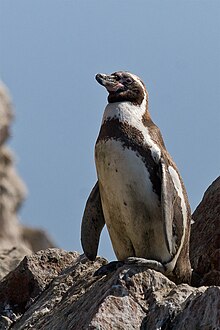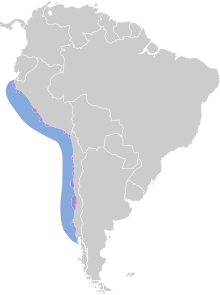| Humboldt penguin | |
|---|---|

| |
| At Islas Ballestas, Peru | |
| Scientific classification | |
| Domain: | Eukaryota |
| Kingdom: | Animalia |
| Phylum: | Chordata |
| Class: | Aves |
| Order: | Sphenisciformes |
| Family: | Spheniscidae |
| Genus: | Spheniscus |
| Species: | S. humboldti
|
| Binomial name | |
| Spheniscus humboldti Meyen, 1834
| |

| |
| Distribution of the Humboldt penguin. 80% of the world's population lives in the protected areas of the Northern Chilean regions III and IV. | |
The Humboldt penguin (Spheniscus humboldti) is a medium-sized penguin. It resides in South America, along the Pacific coast of Peru and Chile.[3] Its nearest relatives are the African penguin, the Magellanic penguin and the Galápagos penguin. The Humboldt penguin and the cold water current it swims in both are named after the explorer Alexander von Humboldt. The species is listed as vulnerable by the IUCN with no population recovery plan in place.[4] The current wild population is composed of roughly 23,800 mature individuals and is declining.[1] It is a migrant species.[5]
Humboldt penguins nest on islands and rocky coasts, burrowing holes in guano and sometimes using scrapes or caves. In South America the Humboldt penguin is found only along the Pacific coast, and the range of the Humboldt penguin overlaps that of the Magellanic penguin on the central Chilean coast. It is vagrant in Ecuador and Colombia.[6] The Humboldt penguin has been known to live in mixed species colonies with the Magellanic penguin in at least two different locations at the south of Chile.[7][8]
The Humboldt penguin has become a focus of ecotourism over the last decades.[9]
- ^ a b BirdLife International (2020). "Spheniscus humboldti". IUCN Red List of Threatened Species. 2020: e.T22697817A182714418. doi:10.2305/IUCN.UK.2020-3.RLTS.T22697817A182714418.en. Retrieved 13 November 2021.
- ^ "Appendices | CITES". cites.org. Retrieved 2022-01-14.
- ^ "Changes in abundance and distribution of Humboldt Penguin. Viana et al, Marine Ornithology 42: 153–159 (2014)" (PDF).
- ^ "The IUCN red list of threatened species retrieved April 2019". IUCN Red List of Threatened Species.
- ^ BirdLife International (2018-08-09). "IUCN Red List of Threatened Species: Humboldt Penguin". IUCN Red List of Threatened Species. Retrieved 2020-04-08.
- ^ C. Michael Hogan (2008) Magellanic Penguin, GlobalTwitcher.com, ed. N. Stromberg Archived 2012-06-07 at the Wayback Machine
- ^ Simeone, Alejandro; Schlatter, Roberto P. (1998). "Threats to a Mixed-Species Colony of Spheniscus Penguins in Southern Chile". Colonial Waterbirds. 21 (3): 418. doi:10.2307/1521654. JSTOR 1521654.
- ^ Hiriart-Bertrand, L.; Simeone, A.; Reyes-Arriagada, R.; Riquelme, V.; Pütz, K.; Lüthi, B. (2010). "Description of a mixed-species colony of Humboldt (Spheniscus humboldti) and Magallanic Penguin (S. magellanicus) at Metalqui Island, Chiloé, southern Chile". Boletín Chileno de Ornitología. 16 (1): 42–47.
- ^ Ellenberg, Ursula; Mattern, Thomas; Seddon, Philip J.; Jorquera, Guillermo Luna (2006-11-01). "Physiological and reproductive consequences of human disturbance in Humboldt penguins: The need for species-specific visitor management". Biological Conservation. 133 (1): 95–106. Bibcode:2006BCons.133...95E. doi:10.1016/j.biocon.2006.05.019. ISSN 0006-3207.
